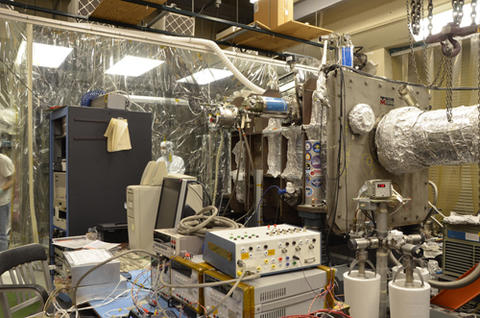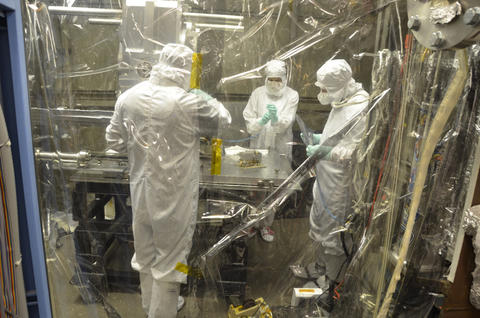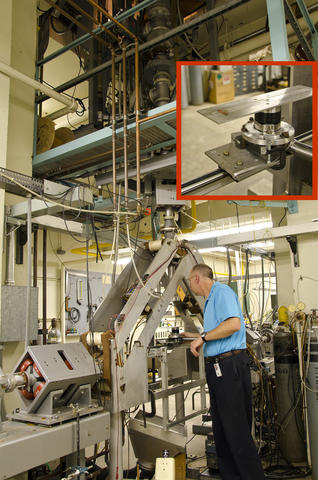Beaming Up on the Way to Space

A SURF beam line (foil-wrapped cylinder at right) ends at a vacuum chamber in which the MAVEN EUV filter radiometer was tested. At left, plastic drapes form a clean room in which the instrument can be extracted from the chamber and from its mounting hardware.
Space may be the final frontier. But often a few trips to PML are necessary before things can get off the ground. One recent case in point is the test of an instrument called the Extreme Ultraviolet Monitor, which will soon be heading for Mars to help answer a vexing question in planetary science: Where did the Red Planet's once-dense atmosphere go?
The obvious answer is: off into space. But why? And how? NASA's Mars Atmosphere and Volatile Evolution mission (MAVEN for short), scheduled for launch in late 2013, will investigate possible causes for the depletion. To model that process, researchers need a detailed understanding of multiple dynamic factors, including what reactions result when sunlight and solar wind hit the Martian atmosphere; how the atmosphere was and is structured; which chemical species are relatively stable; and which are ejected into space at what rate. A data set of that scope will presumably allow planetary scientists to extrapolate backward to a time when Mars was a wetter world.
"We're trying to understand what happens when sunlight and solar wind hit the atmosphere, as well as energetic particles from solar storms and solar flares," says MAVEN PI Bruce Jakosky of the University of Colorado's Laboratory for Atmospheric and Space Physics (LASP). "We want to know what the upper atmospheric response is." An essential part of that research involves measuring the extreme ultraviolet flux. So the MAVEN researchers brought their EUV filter radiometer to NIST's Synchrotron Ultraviolet Radiation Facility (SURF), under the auspices of the Ultraviolet Radiation Group in PML's Sensor Science Division.
They spent a week characterizing the instrument's performance at different wavelengths (1 nm to 7 nm, 17 nm to 22 nm, and the Lyman alpha spectral line at 121 nm), temperatures (5°C to 25 °C), radiation intensities, and orientations, all within a vacuum chamber at the end of a SURF beam line. Although other MAVEN sensors will examine other aspects of the Martian atmosphere, readings from the EUV filter radiometer – which sits in a housing the size of a beer can – will provide particularly significant input.

Judging from its first week of tests, the instrument is up to the task. "We've been able to calibrate it within about 5 percent, which is very good for UV," Eparvier says. The unit will return to SURF one more time before launch for a second round of tests and calibrations. Then after mission launch and a 10-month trip to Mars, the arriving spacecraft will orbit the planet and begin collecting data that will help create an historical portrait painted in gases.
SURF offers exceptional capabilities for this and other space missions. "The SURF spectrometer calibration beamline is unique in the sense that we combine a calculable ultraviolet source, operated in a clean and oil-free ultrahigh vacuum with a large vacuum chamber that can accommodate space instrumentation," says Uwe Arp, a physicist in PML's Ultraviolet Radiation Group.
"Of course, NASA maintains many very large vacuum chambers that can house whole spacecraft, but they don't have them combined with a calculable ultraviolet light source. In addition, SURF is optimized for the spectral range interesting to solar missions, namely the ultraviolet spectral region, whereas most other synchrotron light sources are optimized for x-ray operations. Furthermore, to effectively operate SURF as an absolute source, the storage ring has to be characterized very carefully and many operational parameters have to be monitored during operation, which is not routinely done at other synchrotron light sources."
Meanwhile, in another part of PML, a very different kind of space testing is underway. In this case, a solar-panel manufacturer brings samples of solar cells intended for long-term deployment on various sorts of spacecraft in order to see if the cells can withstand the punishing torrent of charged particles that stream throughout the solar system.

That's a lot of electrons. But Bateman, who manages the small facility, has an ample supply – provided by a powerful Van de Graaff generator that sits directly above the test area. Electrons from the generator are accelerated downward and focused onto a waist-high platform about the size of a small serving tray. Arranged on the platform are several prototype high-efficiency solar cells about 4 cm2 in size, although larger wafer-type cells are also processed.
A motor moves the platform back and forth, and the beam sweeps across the samples. Mounted underneath the platform is a Faraday cup, centered on a small hole, which monitors the electron fluence incident on the samples. "The direct current electron beam typically has an energy of 1 MeV," Bateman says, "although customers sometimes request other energies." In general, the process entails exposing the samples to a range of electron fluences and then making a degradation curve from the data.
Beside radiation-hardness testing, the facility also conducts electron dosimetry studies and materials modification studies using the platform apparatus Bateman says he built for "a couple thousand dollars" using a stepper motor to move the platform and customized software that automates adjustments in the exposure regimen. "In addition," Bateman says, "we look at other applications. For example, I'm assisting groups at Penn State to develop transducer films from electroactive copolymers. In this case, the radiation can actually enhance the electromechanical response. They're trying to find the right combination of materials." Transducers of this sort convert energy of motion into electrical signals, such as in sonar operations.
Ultraviolet sensors and solar cells are only two of the myriad devices that pass through PML on their way to space. Many more will be featured in future editions of PML at Work.

